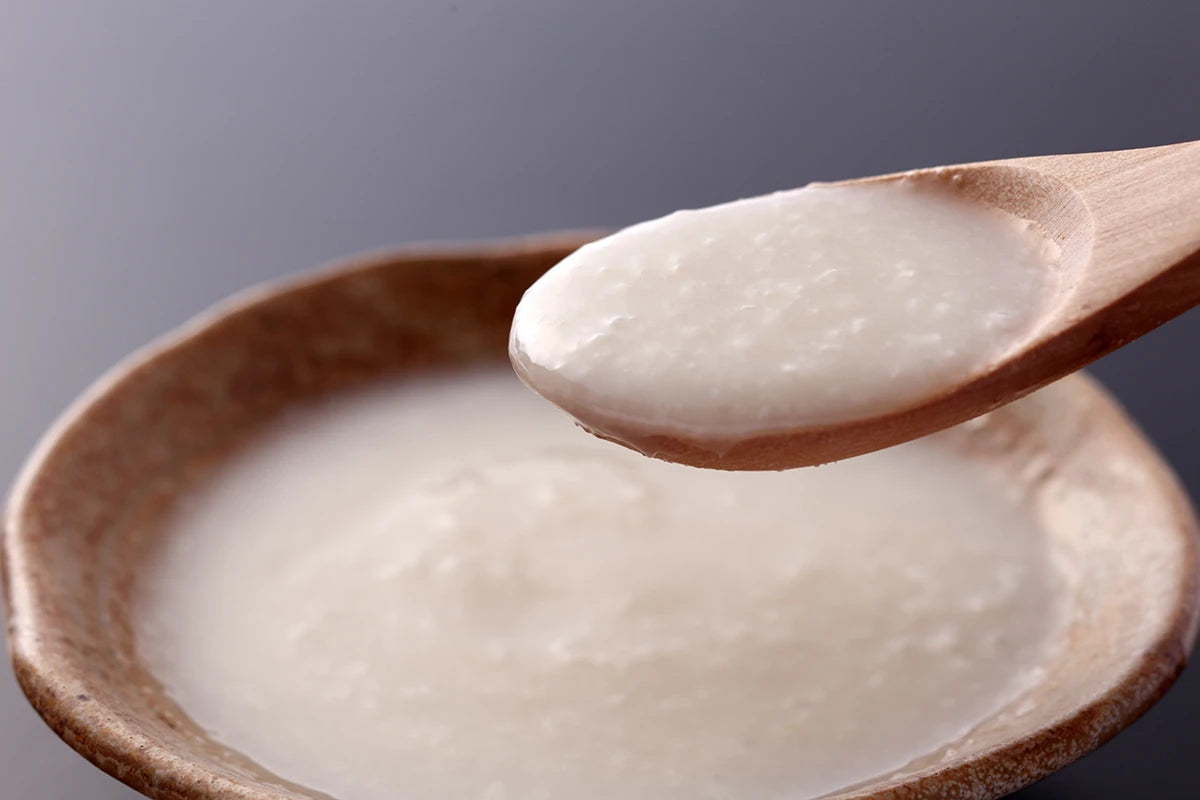
If you have ever enjoyed the deep, savoury flavours of miso soup and soy sauce or the umami in sake, you’ve already experienced the magic of koji mould. A cornerstone of Japanese cuisine, koji is more than just a traditional ingredient—it is a living, transformative tool that has been shaping the culinary landscape of Japan for over a thousand years. But what exactly is koji, and why is this humble mould such a culinary powerhouse.
What is Koji? Understanding Aspergillus Oryzae
Koji refers to grains—usually rice, barley or soybeans—that have been inoculated with a specific mould called Aspergillus oryzae. Koji spores grow on the grains under controlled conditions, these spore play a crucial role by producing enzymes that break down proteins, fats and carbohydrates into simpler compounds like amino acids, fatty acids and sugars. The preparation and fermentation processes are particularly important with rice grains, they need to be flaky, dry and well-separated to ensure proper enzymatic activity. This process of enzymatic transformation brings out complex flavours and forms the foundation for many Japanese fermented foods.
The resulting koji can be used to ferment other ingredients or serve as a seasoning, tenderiser and flavour-enhancer in products like shio koji.

History of Koji
Koji boasts a rich history that stretches back over 2,000 years to ancient Japan. The term “koji” is derived from the Japanese word for “mould” or “fungus,” reflecting its essential role in the fermentation process. Initially, koji was used to ferment rice, barley and soybeans, giving rise to a variety of traditional Japanese foods such as miso, soy sauce and sake. These fermented foods became staples in Japanese cuisine, celebrated for their deep, umami-rich flavours.
As time passed, the use of koji spread throughout Asia, influencing culinary practices in China, Korea and Southeast Asia. Each culture adapted koji to ferment a diverse array of foods, including rice, beans and vegetables. Today, koji remains a cornerstone of Japanese foods and has found its way into global cuisine, appreciated for its ability to enhance flavours and create complex, savoury profiles.
Types of Koji
Koji comes in several varieties, each with its own unique characteristics and culinary uses. The most common type is rice koji, which is used to ferment rice, barley and other grains. This type of koji is integral to the production of sake, amazake and mirin, among other traditional Japanese foods.
Soy koji is another important variety, used primarily to ferment soybeans. It plays a crucial role in making soy sauce and miso, contributing to their distinctive flavours and textures.

Shio koji is a type of koji that is fermented with salt. This versatile ingredient is used as a seasoning and marinade, known for its ability to tenderise food and enhance umami.
Shoyu koji is fermented with soy sauce and is similarly used as a seasoning and marinade. It combines the deep flavours of soy sauce with the enzymatic power of koji, making it a popular choice for adding depth to various dishes.
How is Koji Made?
The process of making koji begins by inoculating a food source, such as rice or soybeans, with a specific type of fungus known as Aspergillus oryzae. This fungus is carefully cultivated to ensure optimal growth and enzyme production. Once inoculated, the grains are kept under controlled conditions of temperature and humidity, allowing the koji mold to flourish.
As the Aspergillus oryzae grows, it breaks down the carbohydrates and proteins in the food source, producing a variety of enzymes and amino acids. These enzymes, including amylase, protease and lipase, are responsible for the unique flavor and texture of koji. The fermentation process can take anywhere from several days to several weeks, depending on the type of koji being produced.

For those interested in making koji at home, you can buy koji rice. The process requires careful attention to environmental conditions to ensure successful fermentation. The resulting koji can then be used to create a range of fermented foods, from miso and soy sauce to innovative new dishes that showcase the versatility and depth of this remarkable ingredient.
The Secret Behind Koji’s Flavour Magic: Umami and Amino Acids
One of the reasons koji is so special is its ability to enhance umami, known as the "fifth taste." Umami provides that savoury, deep and mouth-watering quality found in foods like cheese, tomatoes and mushrooms. The enzymes produced during the koji fermentation process break down proteins into amino acids, particularly glutamate, which is a primary component of umami. This process creates complex, layered flavours that elevate dishes from good to extraordinary.
Subtle variations in Aspergillus and its activity develop in individual production facilities. For example, soy sauce fermentation rooms are never cleaned to allow site specific Aspergillus varieties to remain and thrive. These give individual products unique flavour profiles.
The Many Roles of Koji in Japanese Cuisine
Koji is an essential ingredient for some of Japan's most iconic fermented foods and seasonings:
Soy Sauce (Shoyu): Koji helps break down the soybeans and wheat used in soy sauce, converting them into a flavourful liquid that combines savoury, salty and sweet notes.
Miso: Koji is mixed with soybeans and salt to produce this beloved fermented paste, which adds umami to soups, marinades and sauces.

Sake: When used in sake production, koji breaks down the starch in rice into sugars, which are then fermented by yeast to produce alcohol.
Amazake: A sweet, non-alcoholic fermented rice drink, amazake is made by mixing koji rice with water, creating a thick, naturally sweet beverage.
Mirin: A sweet rice wine used for cooking, mirin gets its depth of flavour from koji's enzymatic breakdown of rice starches.
Why is Koji So Special?
1. **Fermentation Process Powerhouse**
At its core, koji is a natural fermentation starter. The mould releases various enzymes, including:
Amylase: Converts starches into simple sugars.
Protease: Breaks down proteins into amino acids and peptides.
Lipase: Decomposes fats into fatty acids.
These enzymes facilitate the fermentation process, unlocking flavours that would otherwise remain hidden. Unlike other fermentation agents like yeast or lactic acid bacteria, koji’s range of enzymes allows for a more complex breakdown of ingredients, leading to a broader flavour profile.
2. Enhances Umami and Flavour Complexity
Koji doesn’t just add saltiness or sweetness; it brings a multidimensional enhancement to foods. By breaking down proteins into free amino acids like glutamate, it creates a richer, more satisfying taste. This umami effect is crucial for giving depth to dishes like miso soup, soy sauce or even marinated meats.
3. Versatility in Culinary Uses
While traditionally associated with Japanese cuisine, koji is making waves in the global culinary scene.
Dry-Aging: Chefs have discovered that koji can significantly accelerate the dry-aging process for meat, tenderising it and infusing it with umami.

Shio Koji: A mixture of koji, salt and water, shio koji is used as a seasoning or marinade, which tenderises food and adds a depth of flavour.
Vegetarian and Vegan Cooking: Koji can be used to create umami-rich plant-based dishes, acting as a seasoning or an ingredient in sauces, broths and even plant-based cheeses.
4. Nutritional and Health Benefits
Koji not only enhances flavours but also boosts nutritional value. The fermentation process breaks down complex molecules, making nutrients more bioavailable. Additionally, some koji-fermented foods contain beneficial microorganisms that support gut health. The enzymes present can aid in digestion, as they help break down anti-nutrients and improve the overall digestibility of foods.
5.Cultural and Historical Significance
Koji has deep roots in Japanese culture, with its use dating back over a thousand years. It is more than just an ingredient – it is an art form. Traditional koji makers carefully control the growth of Aspergillus oryzae, adjusting temperature and humidity to achieve the perfect balance of flavour and enzyme activity. Koji-making is a cultural craft; expertise including specific techniques of timing mixing and temperature are passed down through generations.
How to Use Shio Koji at Home
For the home cook, koji offers an exciting way to experiment with fermentation:

Shio Koji Marinade:
Mix koji with salt and water and use as a marinade for meats, vegetables or tofu. It acts as a tenderiser and flavour enhancer.
Quick Miso Soup:
Add a spoonful of koji miso paste to hot water for an instant umami boost.
Koji-Aged Steak:
Try dry-aging a steak in koji rice to bring out deep, savoury flavours.

